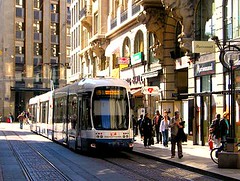Beyond the energy bill: on to transportation

Posted December 19, 2007 at 8:29PM
Warning: serious policy-wonk blog entry coming up.
This week’s enactment by Congress of a 35-mpg vehicle efficiency standard, using a formula that includes SUVs and other so-called “light trucks” (most of the SUVs I see aren’t hauling anything more than the driver and maybe some groceries, but whatever), is a very big deal for the environment and for making progress on reducing global warming emissions. I am incredibly proud of my NRDC colleagues for their role in making this happen, as well as their efforts on behalf of other good features in the new energy bill. It’s not perfect, but it is substantial progress, especially on vehicles and fuels.
 It still won’t get us to where we need to be on carbon emissions unless we also address patterns of transportation. And these are directly connected with land use, since it’s no mystery to anyone other than a dwindling but still-formidable set of old-line transportation policymakers that more sprawl and more roads beget more traffic and emissions.
It still won’t get us to where we need to be on carbon emissions unless we also address patterns of transportation. And these are directly connected with land use, since it’s no mystery to anyone other than a dwindling but still-formidable set of old-line transportation policymakers that more sprawl and more roads beget more traffic and emissions.
Over the next two years, we have a chance to rethink transportation policy in this country. That is because the federal omnibus transportation funding law, SAFETEA-LU (don’t ask; but, trust me, the last two letters are not for “land use”) expires at the end of September, 2009. I hope we can reconceive the whole thing around sustainability.
For decades, this huge and expensive legislation (scores of billions of dollars) was just known as “the highway bill.” From the late 1950s to the 1980s, it was primarily about completing the Interstate highway system.
 There was substantial reform in 1991, when the concept of “efficiency” was introduced into the law. There was still plenty of money devoted to highway construction, but there was also more for public transit, and new programs were introduced to promote intermodal travel, air quality, transparent planning, and flexible funding accounts that could be drawn upon by state and local governments for things other than highways. Some funds were, for the first time, set aside for community enhancements projects related to transportation.
There was substantial reform in 1991, when the concept of “efficiency” was introduced into the law. There was still plenty of money devoted to highway construction, but there was also more for public transit, and new programs were introduced to promote intermodal travel, air quality, transparent planning, and flexible funding accounts that could be drawn upon by state and local governments for things other than highways. Some funds were, for the first time, set aside for community enhancements projects related to transportation.
These reforms did make a difference, but only in the states and communities that chose to take advantage of them. And the highway lobby, which was a little asleep at the wheel in 1991, made sure that there was very little in the way of further reform in the next two bills, in 1998 and 2005.
A lot has happened since then, not least a shift in power in Congress, as the energy bill illustrates. Some of the forces that could set the stage for a more sustainable and equitable approach to transportation include the following:
- The emergence of global warming as a much more prominent national and international concern
- Increased citizen concern about sprawl, traffic congestion, and community livability
- The “green” movement in buildings and industry
- Significantly higher gasoline prices
- Changing demographics that point to changing societal needs, with proportionately more seniors, smaller households, fewer households with school-age children, less demand for large-lot housing, and more societal diversity
- More experience with the shortcomings of road-building as a cost-effective traffic-relief strategy
- More concern over health, obesity, and walkable communities
- Transit ridership now going up rather than down, reversing a longstanding trend
- Better research on the effects of land use on transportation patterns and emissions
- More models of success with smart growth and communities with transportation choices
 Imagine a set of interconnected federal policies that respond to these factors by providing complete streets for walkers, buses and cyclists as well as for cars and trucks, encouraging transit-oriented development and walkable neighborhoods, establishing a set of performance goals for reducing greenhouse gases, respecting landscapes and historic resources, providing funding for smart growth planning, and strengthening regional thinking and community involvement in decision-making.
Imagine a set of interconnected federal policies that respond to these factors by providing complete streets for walkers, buses and cyclists as well as for cars and trucks, encouraging transit-oriented development and walkable neighborhoods, establishing a set of performance goals for reducing greenhouse gases, respecting landscapes and historic resources, providing funding for smart growth planning, and strengthening regional thinking and community involvement in decision-making.
It could happen.